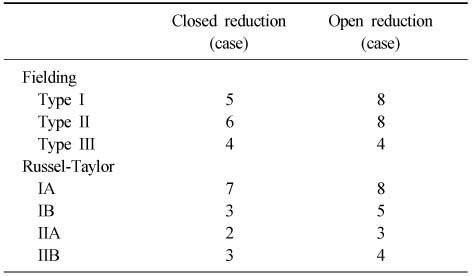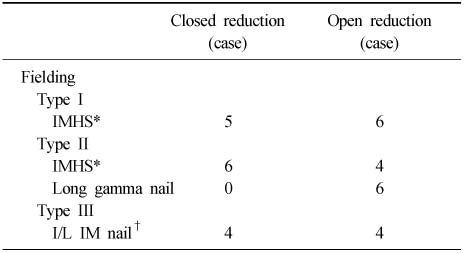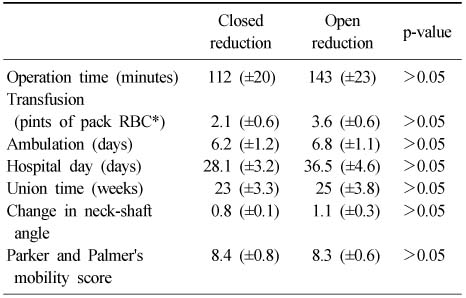Articles
- Page Path
- HOME > J Musculoskelet Trauma > Volume 21(1); 2008 > Article
-
Original Article
- Treatment of Subtrochanteric Femur Fractures Using Intramedullary Devices
- Chung Soo Hwang, M.D., Phil Hyun Chung, M.D., Suk Kang, M.D., Jong Pil Kim, M.D., Young Sung Kim, M.D., Chong Suk Park, M.D., Sang Ho Lee, M.D.
-
Journal of the Korean Fracture Society 2008;21(1):13-18.
DOI: https://doi.org/10.12671/jkfs.2008.21.1.13
Published online: January 31, 2008
Department of Orthopaedic Surgery, College of Medicine, Dongguk University, Gyeongju, Korea.
- Address reprint requests to: Jong Pil Kim, M.D. Department of Orthopaedic Surgery, Dongguk University Gyeongju Hospital, 1090-1, Seokjang-dong, Gyeongju 780-350, Korea. Tel: 82-54-770-8221, Fax: 82-54-770-8378, kjpil@dongguk.ac.kr
Copyright © 2008 The Korean Fracture Society. All rights reserved.
This is an Open Access article distributed under the terms of the Creative Commons Attribution Non-Commercial License (http://creativecommons.org/licenses/by-nc/3.0/) which permits unrestricted non-commercial use, distribution, and reproduction in any medium, provided the original work is properly cited.
- 774 Views
- 3 Download
- 3 Crossref
Abstract
-
Purpose
- The purpose of this study is to compare the result between closed reduction and minimal open reduction in case of difficult reduction for subtrochanteric fractures fixed with intramedullary nail.
-
Materials and Methods
- From Jan. 2001 to May 2005, 35 cases of subtrochanteric femur fracture treated by intramedullary nail and followed up for more than a year were selected out of 42 subtrochanteric femur fractures. Fielding classification and Russel-Taylor classification were used, and according to the fracture classification and method of reduction, the patients were grouped into closed or open reduction group. Fracture with minimal displacement or anatomical reduction was fixed by closed reduction, but in case of failed closed reduction or loss of reduction, minimal incision was made for open reduction and internal fixation, and the result between two groups were compared.
-
Results
- In total of 35 cases, 15 cases were fixed by closed reduction and the rest 20 cases required open reduction. Operation time, amount of transfusion, total hospital days, partial weight bearing ambulation, and union time did not show significant differences between two groups. Ambulation and range of motion after the operation were satisfying in both groups.
-
Conclusion
- In treatment of subtrochanteric femur fracture with intramedullary nail, both closed and open reduction shows satisfying result, therefore when anatomical reduction is difficult to achiev by closed reduction, minimal incision open reduction and additional fixation is strongly recommended to obtain anatomical reduction and firm fixation.
- 1. Asher MA, Tippett JW, Rockwood CA, Zilber S. Compression fixation of subtrochanteric fractures. Clin Orthop Relat Res, 1976;117:202-208.Article
- 2. Aune AK, Ekeland A, Odegaard B, Grogaard B, Alho A. Gamma nail vs compression screw for trochanteric femoral fractures 15 reoperations in a prospective, randomized study of 378 patiens. Acta Orthop Scand, 1994;65:127-130.PubMed
- 3. Canale ST. Campbell's operative orthopedics. 10th ed. Philadelphia: Mosby; 2004. p. 2897-2908.
- 4. Evans EM. Trochanteric fractures; a review of 110 cases treated by nail-plate fixation. J Bone Joint Surg Br, 1951;33:192-204.
- 5. Fernch BG, Tornetta P 3rd. Use of an interlocked cepahlomedullary nail for subtrochanteric fracture stbalilization. Clin Orthop Relat Res, 1998;348:95-100.
- 6. Fielding JW. Subtrochanteric fracture. Clin Orthop Relat Res, 1973;92:86-99.
- 7. Fielding JW, Cochran GV, Zickel RE. Biomechanical characteristics and surgical management of subtrochanteric fractures. Orthop Clin North Am, 1974;5:629-650.ArticlePubMed
- 8. Fogagnolo F, Kfuri M Jr, Paccola CA. Intramedullary fixationof pertrochanteric hip fractures with short AOASIF proximal femoral nail. Arch Orthop Trauma Surg, 2004;124:31-37.ArticlePubMedPDF
- 9. Froimson AI. Treatment of communited subtrochanteric fractures of the femur. Surg Gynecol Obstet, 1970;131:465-472.PubMed
- 10. Jeon TS, Kim WS, Kim SB, Hwang CM, Kim KT, Kim SH. Treatment of communited subtrochatneric fractures of the femur by high energy trauma. J Korean Fract Soc, 2006;19:135-140.Article
- 11. Windolf J, Hollander DA. Pitfalls and complications in the use of the proximal femoral nail. Langenbecks Arch Surg, 2005;390:59-65.ArticlePubMedPDF
- 12. Kaufer H. Mechanics of the treatment hip hip injuries. Clin Orthop Relat Res, 1980;146:53-61.
- 13. Rockwood CA Jr, Green IP, Buchilz RW, Heckman JD. Fractures in adults. 4th ed. Philadelphia: Lippincott-Raven; 1996. p. 1741-1756.
- 14. Parker MJ, Palmer CR. A new mobility for predicting mortality after hip fracture. J Bone Joint Surg Br, 1993;75:797-798.PubMed
- 15. Schatzker J, Waddell JP. Subtrochanteric fractures of the femur. Orthop Clin North Am, 1980;11:539-554.ArticlePubMed
- 16. Thorngren KG. Optimal treatment of hip fractures. Acta Orthop Scand Suppl, 1991;241:31-34.ArticlePubMed
- 17. Velasco RU, Comfort TH. Analysis of treatment problems in subtrochanteric fractures of the femur. J Trauma, 1978;18:518-523.Article
- 18. Watson HK, Campbell RD Jr, Wade PA. Classification, treatment and complications of the adult subtrochanteric fractures. J Trauma, 1964;60:457-480.
- 19. Wiss DA, Brien WW. Subtrochanteric fractures of the femur. Results of treatment by interlocking nailing. Clin Orthop Relat Res, 1992;283:231-236.Article
- 20. Zickel RE. An intramedullary fixation device for the proximal part of the femur. Nine year's experience. J Bone Joint Surg Am, 1976;58:866-872.ArticlePubMed
REFERENCES
Fig. 1
(B) The patient was treated by minial open reduction with long gamma nail and wiring.
(C) Post operative AP radiograph taken 8 months after the operation showed solid union.

(A) 24 years old male had subtrochanteric demur fracture due to traffic accident.

Fig. 2
(B) The patient was treated by minimal open reduction and intramedullary hip screw. He needed additional wiring and bone graft.
(C) A year after the operation, the solid union was confirmed by AP radiograph.

(A) 43 years old male had subtrochanteric femur fracture.

Figure & Data
REFERENCES
Citations
Citations to this article as recorded by 

- Factors Affecting Time to Bony Union of Femoral Subtrochanteric Fractures Treated with Intramedullary Devices
Jung-Yoon Choi, Yerl-Bo Sung, Jin-Hee Yoo, Sung-Jae Chung
Hip & Pelvis.2014; 26(2): 107. CrossRef - Fixation of the Femoral Subtrochanteric Fracture with Minimally Invasive Reduction Techniques
Chul-Hyun Park, Chul-Wung Ha, Sang-Jin Park, Min-Su Ko, Oog-Jin Shon
Journal of the Korean Fracture Society.2013; 26(2): 112. CrossRef - Treatment of Subtrochanteric Nonunion with a Blade Plate
Youn-Soo Park, Jin-Hong Kim, Kyung-Jea Woo, Seung-Jae Lim
Journal of the Korean Orthopaedic Association.2011; 46(1): 42. CrossRef
Treatment of Subtrochanteric Femur Fractures Using Intramedullary Devices


Fig. 1
(A) 24 years old male had subtrochanteric demur fracture due to traffic accident.
(B) The patient was treated by minial open reduction with long gamma nail and wiring.
(C) Post operative AP radiograph taken 8 months after the operation showed solid union.
Fig. 2
(A) 43 years old male had subtrochanteric femur fracture.
(B) The patient was treated by minimal open reduction and intramedullary hip screw. He needed additional wiring and bone graft.
(C) A year after the operation, the solid union was confirmed by AP radiograph.
Fig. 1
Fig. 2
Treatment of Subtrochanteric Femur Fractures Using Intramedullary Devices
Classification by Fielding and Russel-Taylor classification
Classification by Fielding and selection of internal device
*IMHS: Intramedullary hip screw, †I/L IM nail: Interlocking intramedullary nail.
Comparison of results between closed ruduction and open reduction
*RBC: Red blood cell.
Table 1
Classification by Fielding and Russel-Taylor classification
Table 2
Classification by Fielding and selection of internal device
*IMHS: Intramedullary hip screw, †I/L IM nail: Interlocking intramedullary nail.
Table 3
Comparison of results between closed ruduction and open reduction
*RBC: Red blood cell.

 E-submission
E-submission KOTA
KOTA TOTA
TOTA TOTS
TOTS



 Cite
Cite

